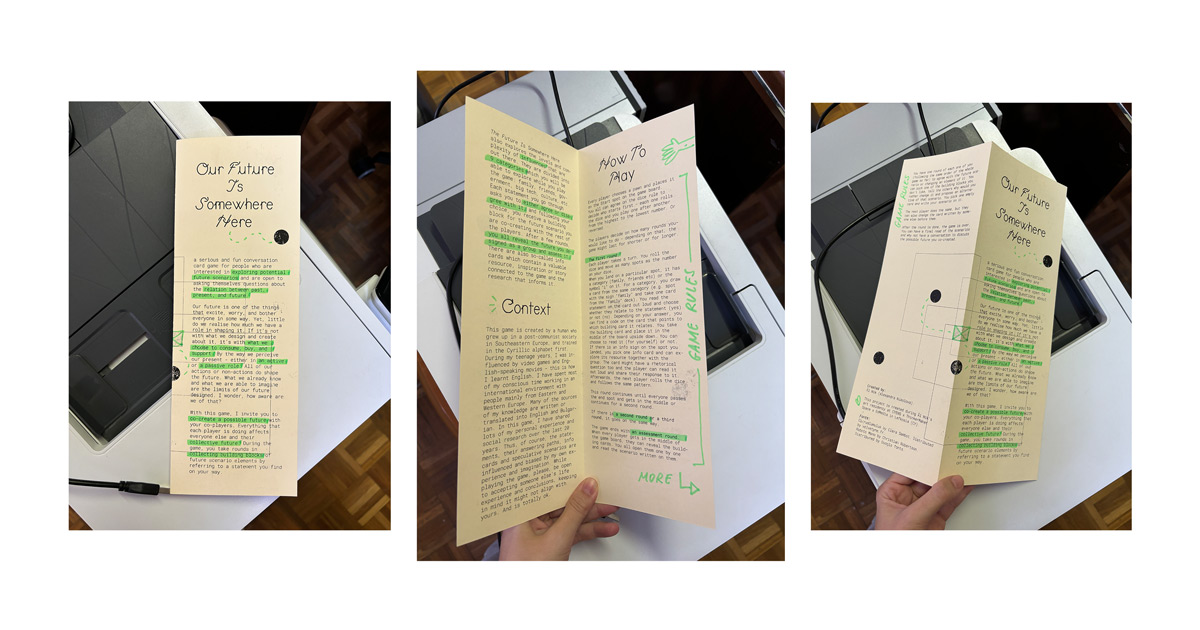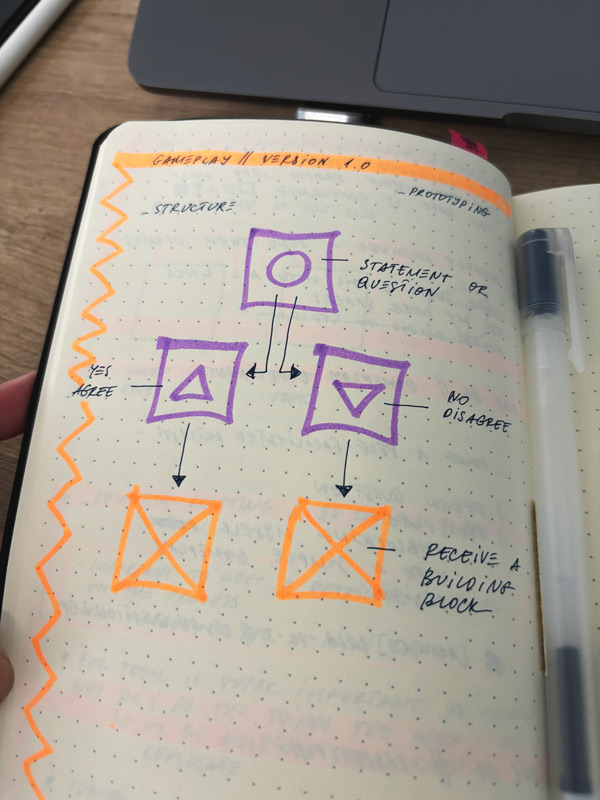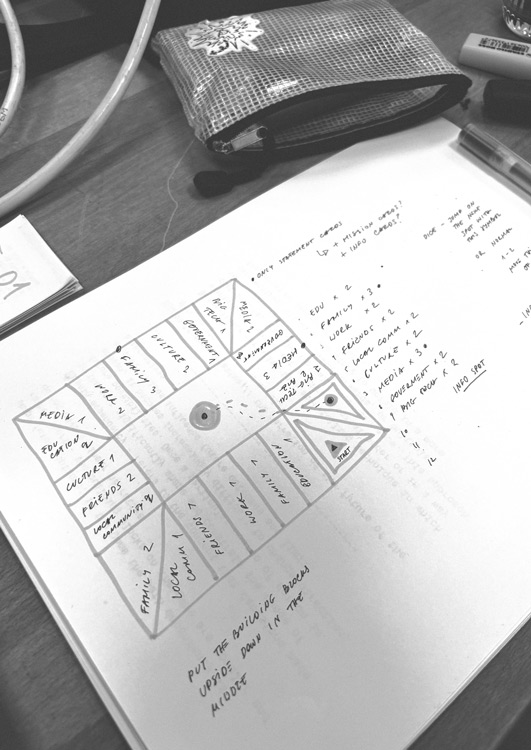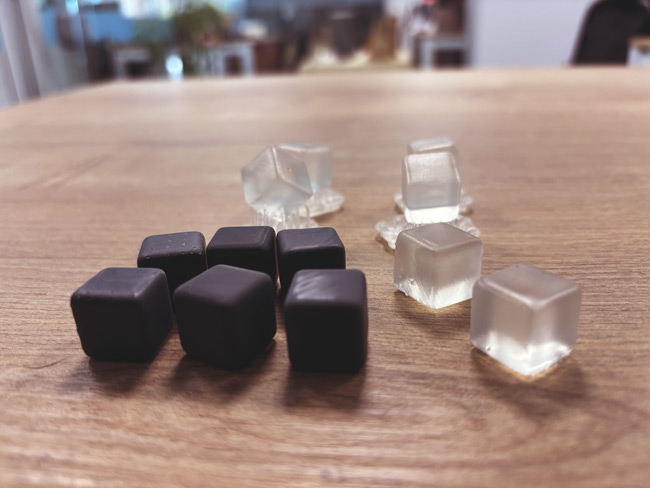Our Future Is Somewhere Here: Difference between revisions
m (→_game rules) |
m (→_editorial) |
||
| Line 39: | Line 39: | ||
+ exploration of possible worlds <br> | + exploration of possible worlds <br> | ||
+ path dependency <br> | + path dependency <br> | ||
+ modularity and non-linear narration <br> | |||
+ counterfactual reasoning <br> | + counterfactual reasoning <br> | ||
+ simplification (sometimes extreme) <br> | + simplification (sometimes extreme) <br> | ||
Revision as of 14:08, 28 October 2024
_work-in-progress
_editorial
// version 2.0 // 28-10-2024
// version 1.0 // 16-10-2024
_Introduction
Our Future Is Somewhere Here is a serious and fun conversation card game for people who are interested in exploring potential future scenarios and are open to asking themselves questions about the relation between past, present, and future.
Our future is one of the things that excite, worry, and bother everyone in some way. Yet, little do we realise how much we have a role in shaping it. If it’s not with what we design and create about it, it’s with what we choose to consume, buy, and support. By the way we perceive our present - either in an active or a passive role. All of our actions or non-actions do shape the future. What we already know and what we are able to imagine are the limits of our future designed. I wonder, how aware are we of that?
With this game, I invite you to co-create a possible future with your co-players. Everything that each player is doing affects everyone else and their collective future. During the game, you take rounds in collecting building blocks of future scenario elements by referring to a statement you find on your way.
Our Future Is Somewhere Here also explores the levels and complexity of influences that are out there. They are divided into 9 categories which you will be able to explore while you play the game: family, friends, government, big tech, culture, etc. Each statement you go through asks you to either agree or disagree with it, and following your choice, you receive a building block for the future scenario you are co-creating with the rest of the players. After a few rounds, you all reveal the future you designed as a group and assess it. There are also so-called info cards which contain a valuable resource, inspiration or story connected to the game and the research that informs it.
Will you leave with more questions than answers after playing the game?
_Goals of the game
With this game, I aim to bring awareness about how our past and present influence the future and especially our role in it. As human beings part of an extremely complex system, we often feel powerless and underestimate our role as individuals and as a community in shaping the future. In reality, our actions and non-actions actually matter - we are always part of a social system and as such, we influence the other parts of the same system.
I am also excited to create a space for connection. I would like to invite the players to be open to new discoveries during this game - about themselves and the others. This game is a facilitated conversation opener, be mindful of the others and give space for everyone to express and contribute. It is a collective game, not a game about competition.
This game also aims to bring an understanding of how designing a potential future could look like, what elements influence it, and what is our role in it.
_Context This game is created by a human who grew up in a post-communist society in Southeastern Europe, and trained in the Cyrillic alphabet first. During my teenage years, I was influenced by video games and English-speaking movies - this is how I learnt English. I have spent most of my conscious time working in an international environment with people mainly from Eastern and Western Europe. Many of the sources of my knowledge are written or translated into English and Bulgarian. In this game, I have shared lots of my personal experience and social research over the last 20 years. Thus, of course, the statements, their answering paths, info cards and speculative scenarios are influenced and biased by my own experience and imagination. While playing the game, please, be open to accepting someone else’s life experience and conclusions, keeping in mind it might not align with yours. And is totally ok.
_Methods
for designing the relation between statements and outcomes for the building blocks:
+ speculative fiction
+ exploration of possible worlds
+ path dependency
+ modularity and non-linear narration
+ counterfactual reasoning
+ simplification (sometimes extreme)
+ exaggeration (for dramatic effects)
+ entanglement (Karen Barad’s concept of agential realism: “all entities are intertwined, continually shaping and reshaping each other in the process of their existence”)
+ diffraction (KB, examining differences that emphasizes interaction, transformation, and entangled relations rather than simple reflection or mirroring)
↳ examine how elements transform each other. For instance, studying how a concept evolves across different contexts can reveal unique "interference patterns" in thought.
↳ to trace how differences are not fixed but relational. For example, in social sciences, this could involve analyzing how different perspectives on an issue actively shape one another, creating new insights rather than simply opposing views.
_game design
_prototypes
_final version
_game elements
_game rules
_How To Play
Every player chooses a pawn and places it on the Start spot on the game board. The players can agree on the dice rule to decide who starts first - each one of them rolls the dice and they play one after another from the highest to the lowest number. Or reversed.
The players decide on how many rounds they would like to do - depending on that, the game might last for a different time.
▲ The first round: Each player takes a turn. They roll the dice and move as many spots as the number on their dice. When they land on a particular spot, it has a category (family, friends etc) or the symbol “i” on it. For a category, the player draws a card from the same category (e.g. spot with the sign “family” and takes one card from the “family” deck). They read the statement on the card out loud and choose whether they relate to the statement (yes) or not (no). Depending on their answer, they can find a code on the card that points to which building card it relates. They can take the building card and place it in the middle of the board upside down. They can read it (for themself) or not. If there is an info sign on the spot they landed, they pick one info card and can explore its resource together with the group. The card has a rhetorical question and the player can read it out loud and share their response to it. Afterwards, the next player rolls the dice and follows the same pattern.
This round continues until everyone passes the end spot and gets in the middle or continues for a second round.
▲ If there is a second round or a third round, it goes on the same way.
▲ The game ends with an assessment round. When every player gets in the middle of the game board, they can reveal the building cards. They open them one by one and read the scenario written on them.
They have one round of each of them agreeing with the future scenario or changing an element of it. They can pick one of the building blocks they don’t like, tell the others why they would rather change it and propose an alternative of that scenario. They pick one empty card and write it down on it. The next player does the same, but they can also change the card written by someone else.
After the round is done, the game is over. The players can have a final read and they can have a conversation to discuss the possible future they co-created.



